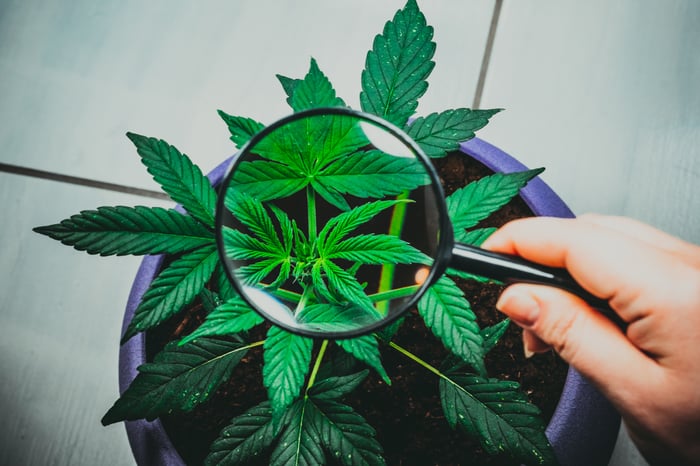In case you missed it, something interesting happened in the marijuana industry over the past couple of weeks. Namely, Cronos Group (CRON -0.82%) surpassed Tilray (TLRY) to become the third-largest publicly traded pot stock in the world behind only Canopy Growth (CGC -3.13%) and Aurora Cannabis (ACB -1.86%).
Why Cronos Group leaped over Tilray into the No. 3 spot
The lift for Cronos Group came from the closing of the $1.8 billion equity investment into the company by Altria (MO 0.86%). Upon closing, Altria took a nondiluted 45% stake in Cronos, with the potential to up its ownership to 55% if it chooses to execute warrants that were received as part of the investment. Considering the precipitous decline in tobacco shipment volumes that Altria has been contending with in the U.S., this investment gives the U.S. tobacco king access to a rapidly growing trend (i.e., cannabis) in North America.

Image source: Getty Images.
Meanwhile, the $1.8 billion cash infusion from Altria vaulted Cronos to the No. 2 spot in terms of cash on hand among pot stocks, behind only Canopy Growth. The company ended the previous quarter with less than $25 million in cash on hand, so the $1.8 billion now gives it the freedom to execute on its long-term strategy.
Meanwhile, around the same time as Cronos Group closed on its equity investment from Altria, Tilray reported its fourth-quarter results. The $15.5 million in sales, the 20% gross margin, and the $0.33 per share loss were all less-than-desirable outcomes after Canada had legalized recreational marijuana this past October. Plus, with Tilray CEO Brendan Kennedy announcing that the company would focus its efforts on the U.S. and Europe, essentially throwing in the towel on future investments in Canada, it looks as if Tilray is a rudderless ship adrift at sea for the time being.
Add this up, and it's pretty easy to see how Cronos Group usurped the No. 3 market-cap spot from Tilray. But let's make one thing very clear: Cronos Group can't hold a candle to Aurora Cannabis or Canopy Growth.

Image source: Getty Images.
Canopy and Aurora could run circles around Cronos
Even though Cronos now finds itself in elite company among marijuana stocks, it has very little going for it beyond its Altria equity investment. Aside from this cash and Cronos Group's up to $100 million deal with Ginkgo Bioworks to develop cannabinoids at commercial scale, the company has absolutely no business being listed anywhere near Canopy or Aurora.
On the basis of production, Aurora Cannabis is liable to lead all growers with around 700,000 kilos in peak yield by 2021 or 2022. Canopy Growth, while more tight-lipped about its peak yearly output, does have more than 4.3 million square feet of its 5.6 million square feet already licensed by Health Canada. This should put the company on track for (comfortably) more than 500,000 kilos in peak annual production. Meanwhile, Cronos Group would have to scrape every bud together to maybe hit 120,000 kilos a year of output.
Delving deeper into production, Aurora Cannabis has more than a dozen facilities that will help it reach No. 1 production status. Canopy Growth has 10 facilities accounting for its 5.6 million square feet. As for Cronos Group, it has an 850,000-square-foot joint venture capable of 70,000 kilos at its peak; Peace Naturals, which will yield 40,000 kilos at its maximum, and three other marginally producing facilities. In another context, Aurora has three facilities that come close to outproducing Cronos Group -- if not flat-out doing so.

Image source: Getty Images.
Additionally, Aurora Cannabis has pushed into 24 total markets, with Canopy Growth easily surpassing one dozen. These international sales channels are extremely important given the likelihood that dried cannabis flower will eventually be oversupplied and commoditized in Canada. Thus, having a presence in overseas markets will ensure that Aurora and Canopy don't see their domestic operating margins get ransacked by falling per-gram prices for dried flower.
As for Cronos, it has a small production presence in Australia and Israel, as well as distribution platforms in Poland and Germany. But that's about it when it comes to international expansion.
To make this comparison even more night-and-day, Canopy Growth and Aurora Cannabis reported sales of $62.3 million and $40.6 million, respectively, in their most recent quarter. Comparatively, even with recreational legalization, Cronos Group managed only $4.2 million in sales. It was surpassed by numerous growers with significantly smaller market caps.
In sum, yes, Cronos Group is the new No. 3 in market cap among pot stocks. But no, it doesn't remotely deserve to be anywhere near the top of the list. My suggestion is to not become enamored with Cronos Group's recent success and instead avoid what looks to be the most overvalued marijuana stock of them all.





